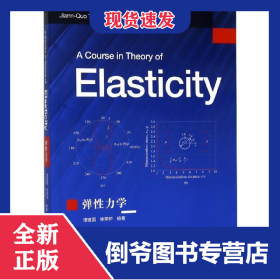
弹性力学(英文版)
全新正版 极速发货
¥ 46.99 6.9折 ¥ 68 全新
库存4件
广东广州
认证卖家担保交易快速发货售后保障
作者编者:谭建国//徐荣桥
出版社浙江大学
ISBN9787308186681
出版时间2019-06
装帧其他
开本其他
定价68元
货号1201923133
上书时间2024-05-26
- 最新上架
商品详情
- 品相描述:全新
- 商品描述
-
目录
Chapter 1 Mathematical Prerequisites
1.1 Index Notation
1.1.1 Range convention
1.1.2 Summation convention
1.1.3 The Kronecker delta
1.1.4 The permutation symbol
1.2 Vector Operations and Some Useful Integral Theorems
1.2.1 The scalar product of two vectors
1.2.2 The vector product of two vectors
1.2.3 The scalar triple product
1.2.4 The gradient of a scalar function
1.2.5 The divergence of a vector function
1.2.6 The curl of a vector function
1.2.7 Laplacian of a scalar function
1.2.8 Divergence theorem (Gauss's theorem)
1.2.9 Stokes' theorem
1.2.10 Green's theorem
1.3 Cartesian Tensors and Transformation Laws
Problems 1
Chapter 2 Analysis of Stress
2.1 Continuum
2.2 Forces
2.3 Cauchy's Formula
2.4 Equations of Equilibrium
2.5 Stress as a Second-order Tensor
2.6 Principal Stresses
2.7 Maximum Shears
2.8 Yields Criteria
Problems 2
Chapter 3 Analysis of Strain
3.1 Differential Element Considerations
3.2 Linear Deformation and Strain
3.3 Strain as a Second-order Tensor
3.4 Principal Strains and Strain Measurement
3.5 Compatibility Equations
3.6 Finite Deformation
Problems 3
Chapter 4 Linear Elastic Materials, Framework of Problems of Elasticity
4.1 Introduction
4.2 Uniaxial Stress-Strain Relations of Linear Elastic Materials
4.3 Hooke's Law
4.3.1 Isotropic materials
4.3.2 Orthotropic materials
4.3.3 Transversely isotropic materials
4.4 Generalized Hooke's Law
4.5 Elastic Constants as Components of a Fourth-order Tensor
4.6 Elastic Symmetry
4.6.1 One plane of elastic symmetry (monoclinic material)
4.6.2 Two planes of elastic symmetry
4.6.3 Three planes of elastic symmetry (orthotropic material)
内容摘要
主要内容包括笛卡尔张量、应力理论、应变分析、弹性力学本构关系、弹性力学问题的一般理论、平面问题的直角坐标解法和极坐标解法、柱形杆的扭转和弯曲、空间问题和接触问题、热应力、弹性波的传播、弹性力学问题的复变函数解法、弹性力学问题的变分解法等。
相关推荐
— 没有更多了 —






















以下为对购买帮助不大的评价